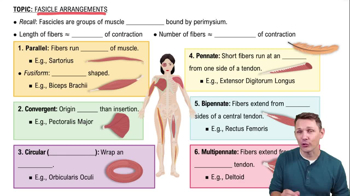Here are the essential concepts you must grasp in order to answer the question correctly.
Muscle Fiber Arrangement
Muscle fiber arrangement refers to the orientation of muscle fibers in relation to the tendons. This arrangement affects the muscle's strength, range of motion, and overall function. Different patterns, such as parallel or pennate, influence how force is generated and how efficiently a muscle can contract.
Recommended video:
Pennate Muscles
Pennate muscles are characterized by their fibers being arranged at an angle to the tendon, resembling a feather. This structure allows for a greater number of fibers to be packed into a given muscle volume, enhancing force production. There are three types of pennate muscles: unipennate, bipennate, and multipennate, each with distinct functional properties.
Recommended video:
Introduction to Muscles and Muscle Tissue Example 1
Types of Muscle Arrangements
Muscle arrangements can be classified into several types, including circular, longitudinal, pennate, and parallel. Each type has unique characteristics that determine its mechanical advantages. For instance, circular muscles are designed for constriction, while parallel muscles are optimized for greater range of motion, highlighting the importance of arrangement in muscle function.
Recommended video:
 Verified step by step guidance
Verified step by step guidance


